Qian Du
Aerial Multi-View Stereo via Adaptive Depth Range Inference and Normal Cues
Jun 06, 2025Abstract:Three-dimensional digital urban reconstruction from multi-view aerial images is a critical application where deep multi-view stereo (MVS) methods outperform traditional techniques. However, existing methods commonly overlook the key differences between aerial and close-range settings, such as varying depth ranges along epipolar lines and insensitive feature-matching associated with low-detailed aerial images. To address these issues, we propose an Adaptive Depth Range MVS (ADR-MVS), which integrates monocular geometric cues to improve multi-view depth estimation accuracy. The key component of ADR-MVS is the depth range predictor, which generates adaptive range maps from depth and normal estimates using cross-attention discrepancy learning. In the first stage, the range map derived from monocular cues breaks through predefined depth boundaries, improving feature-matching discriminability and mitigating convergence to local optima. In later stages, the inferred range maps are progressively narrowed, ultimately aligning with the cascaded MVS framework for precise depth regression. Moreover, a normal-guided cost aggregation operation is specially devised for aerial stereo images to improve geometric awareness within the cost volume. Finally, we introduce a normal-guided depth refinement module that surpasses existing RGB-guided techniques. Experimental results demonstrate that ADR-MVS achieves state-of-the-art performance on the WHU, LuoJia-MVS, and M\"unchen datasets, while exhibits superior computational complexity.
Prototype-Based Information Compensation Network for Multi-Source Remote Sensing Data Classification
May 06, 2025Abstract:Multi-source remote sensing data joint classification aims to provide accuracy and reliability of land cover classification by leveraging the complementary information from multiple data sources. Existing methods confront two challenges: inter-frequency multi-source feature coupling and inconsistency of complementary information exploration. To solve these issues, we present a Prototype-based Information Compensation Network (PICNet) for land cover classification based on HSI and SAR/LiDAR data. Specifically, we first design a frequency interaction module to enhance the inter-frequency coupling in multi-source feature extraction. The multi-source features are first decoupled into high- and low-frequency components. Then, these features are recoupled to achieve efficient inter-frequency communication. Afterward, we design a prototype-based information compensation module to model the global multi-source complementary information. Two sets of learnable modality prototypes are introduced to represent the global modality information of multi-source data. Subsequently, cross-modal feature integration and alignment are achieved through cross-attention computation between the modality-specific prototype vectors and the raw feature representations. Extensive experiments on three public datasets demonstrate the significant superiority of our PICNet over state-of-the-art methods. The codes are available at https://github.com/oucailab/PICNet.
Frequency-Compensated Network for Daily Arctic Sea Ice Concentration Prediction
Apr 23, 2025Abstract:Accurately forecasting sea ice concentration (SIC) in the Arctic is critical to global ecosystem health and navigation safety. However, current methods still is confronted with two challenges: 1) these methods rarely explore the long-term feature dependencies in the frequency domain. 2) they can hardly preserve the high-frequency details, and the changes in the marginal area of the sea ice cannot be accurately captured. To this end, we present a Frequency-Compensated Network (FCNet) for Arctic SIC prediction on a daily basis. In particular, we design a dual-branch network, including branches for frequency feature extraction and convolutional feature extraction. For frequency feature extraction, we design an adaptive frequency filter block, which integrates trainable layers with Fourier-based filters. By adding frequency features, the FCNet can achieve refined prediction of edges and details. For convolutional feature extraction, we propose a high-frequency enhancement block to separate high and low-frequency information. Moreover, high-frequency features are enhanced via channel-wise attention, and temporal attention unit is employed for low-frequency feature extraction to capture long-range sea ice changes. Extensive experiments are conducted on a satellite-derived daily SIC dataset, and the results verify the effectiveness of the proposed FCNet. Our codes and data will be made public available at: https://github.com/oucailab/FCNet .
Dynamic Cross-Modal Feature Interaction Network for Hyperspectral and LiDAR Data Classification
Mar 10, 2025Abstract:Hyperspectral image (HSI) and LiDAR data joint classification is a challenging task. Existing multi-source remote sensing data classification methods often rely on human-designed frameworks for feature extraction, which heavily depend on expert knowledge. To address these limitations, we propose a novel Dynamic Cross-Modal Feature Interaction Network (DCMNet), the first framework leveraging a dynamic routing mechanism for HSI and LiDAR classification. Specifically, our approach introduces three feature interaction blocks: Bilinear Spatial Attention Block (BSAB), Bilinear Channel Attention Block (BCAB), and Integration Convolutional Block (ICB). These blocks are designed to effectively enhance spatial, spectral, and discriminative feature interactions. A multi-layer routing space with routing gates is designed to determine optimal computational paths, enabling data-dependent feature fusion. Additionally, bilinear attention mechanisms are employed to enhance feature interactions in spatial and channel representations. Extensive experiments on three public HSI and LiDAR datasets demonstrate the superiority of DCMNet over state-of-the-art methods. Our code will be available at https://github.com/oucailab/DCMNet.
Global and Local Attention-Based Transformer for Hyperspectral Image Change Detection
Nov 21, 2024
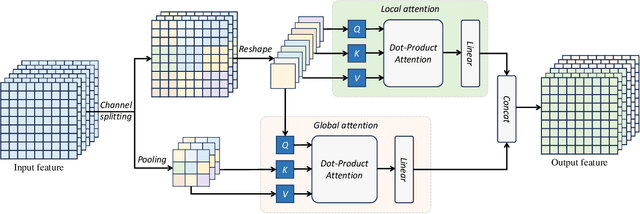
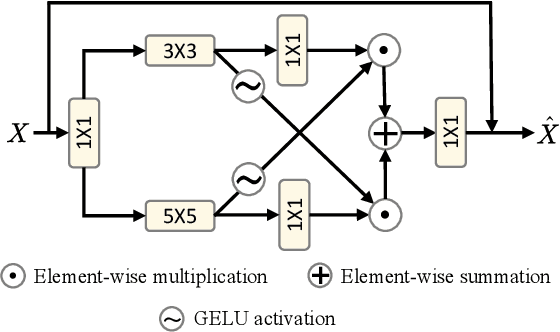
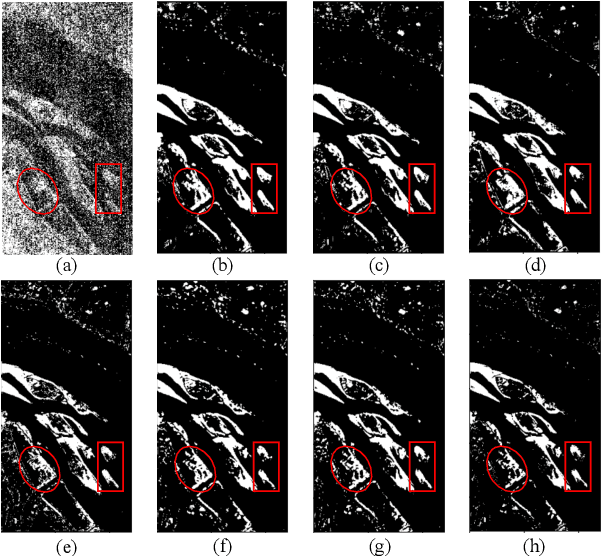
Abstract:Recently Transformer-based hyperspectral image (HSI) change detection methods have shown remarkable performance. Nevertheless, existing attention mechanisms in Transformers have limitations in local feature representation. To address this issue, we propose Global and Local Attention-based Transformer (GLAFormer), which incorporates a global and local attention module (GLAM) to combine high-frequency and low-frequency signals. Furthermore, we introduce a cross-gating mechanism, called cross-gated feed-forward network (CGFN), to emphasize salient features and suppress noise interference. Specifically, the GLAM splits attention heads into global and local attention components to capture comprehensive spatial-spectral features. The global attention component employs global attention on downsampled feature maps to capture low-frequency information, while the local attention component focuses on high-frequency details using non-overlapping window-based local attention. The CGFN enhances the feature representation via convolutions and cross-gating mechanism in parallel paths. The proposed GLAFormer is evaluated on three HSI datasets. The results demonstrate its superiority over state-of-the-art HSI change detection methods. The source code of GLAFormer is available at \url{https://github.com/summitgao/GLAFormer}.
A Generalized Tensor Formulation for Hyperspectral Image Super-Resolution Under General Spatial Blurring
Sep 27, 2024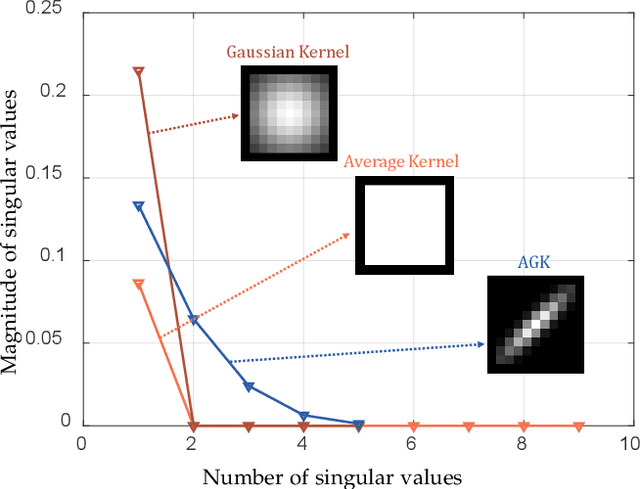
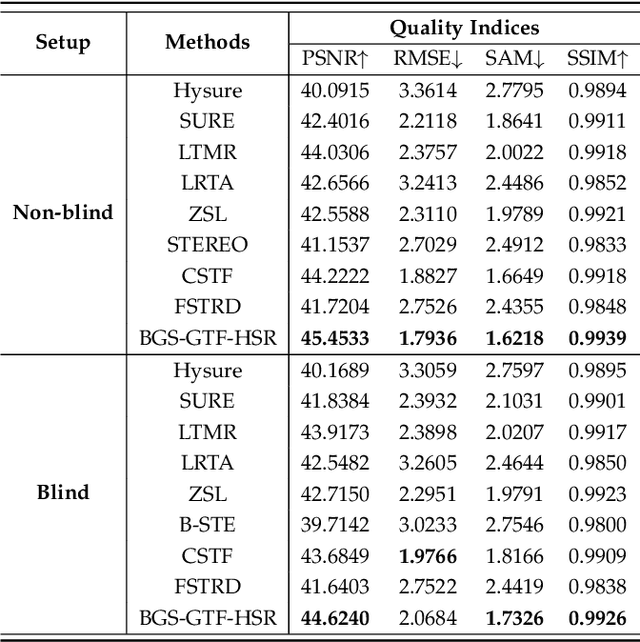

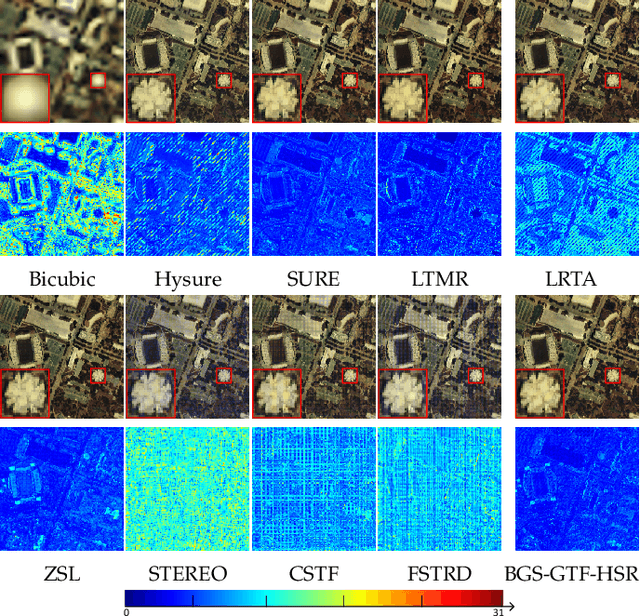
Abstract:Hyperspectral super-resolution is commonly accomplished by the fusing of a hyperspectral imaging of low spatial resolution with a multispectral image of high spatial resolution, and many tensor-based approaches to this task have been recently proposed. Yet, it is assumed in such tensor-based methods that the spatial-blurring operation that creates the observed hyperspectral image from the desired super-resolved image is separable into independent horizontal and vertical blurring. Recent work has argued that such separable spatial degradation is ill-equipped to model the operation of real sensors which may exhibit, for example, anisotropic blurring. To accommodate this fact, a generalized tensor formulation based on a Kronecker decomposition is proposed to handle any general spatial-degradation matrix, including those that are not separable as previously assumed. Analysis of the generalized formulation reveals conditions under which exact recovery of the desired super-resolved image is guaranteed, and a practical algorithm for such recovery, driven by a blockwise-group-sparsity regularization, is proposed. Extensive experimental results demonstrate that the proposed generalized tensor approach outperforms not only traditional matrix-based techniques but also state-of-the-art tensor-based methods; the gains with respect to the latter are especially significant in cases of anisotropic spatial blurring.
MSFMamba: Multi-Scale Feature Fusion State Space Model for Multi-Source Remote Sensing Image Classification
Aug 26, 2024Abstract:In multi-source remote sensing image classification field, remarkable progress has been made by convolutional neural network and Transformer. However, existing methods are still limited due to the inherent local reductive bias. Recently, Mamba-based methods built upon the State Space Model have shown great potential for long-range dependency modeling with linear complexity, but it has rarely been explored for the multi-source remote sensing image classification task. To this end, we propose Multi-Scale Feature Fusion Mamba (MSFMamba) network for hyperspectral image (HSI) and LiDAR/SAR data joint classification. Specifically, MSFMamba mainly comprises three parts: Multi-Scale Spatial Mamba (MSpa-Mamba) block, Spectral Mamba (Spe-Mamba) block, and Fusion Mamba (Fus-Mamba) block. Specifically, to solve the feature redundancy in multiple canning routes, the MSpa-Mamba block incorporates the multi-scale strategy to minimize the computational redundancy and alleviate the feature redundancy of SSM. In addition, Spe-Mamba is designed for spectral feature exploration, which is essential for HSI feature modeling. Moreover, to alleviate the heterogeneous gap between HSI and LiDAR/SAR data, we design Fus-Mamba block for multi-source feature fusion. The original Mamba is extended to accommodate dual inputs, and cross-modal feature interaction is enhanced. Extensive experimental results on three multi-source remote sensing datasets demonstrate the superiority performance of the proposed MSFMamba over the state-of-the-art models. Source codes of MSFMamba will be made public available at https://github.com/summitgao/MSFMamba .
BihoT: A Large-Scale Dataset and Benchmark for Hyperspectral Camouflaged Object Tracking
Aug 22, 2024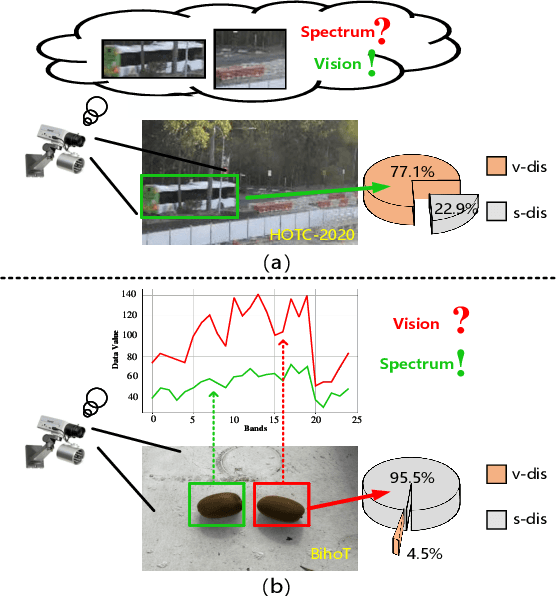
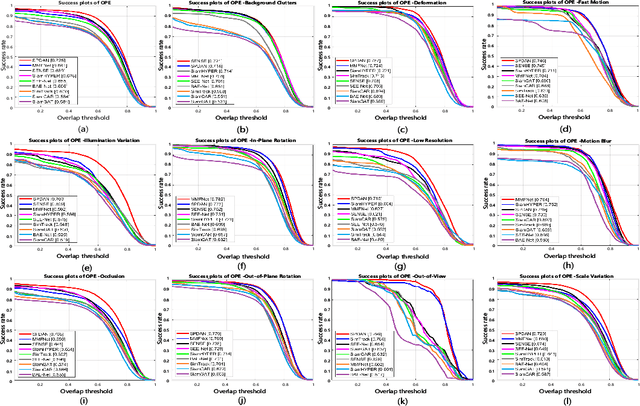

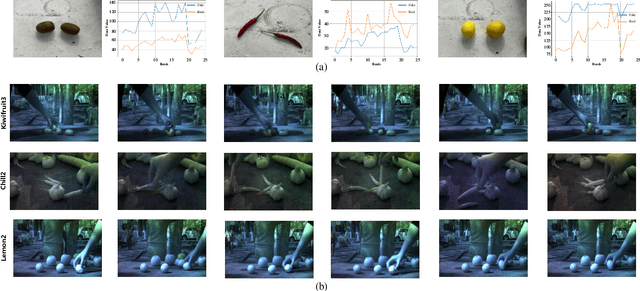
Abstract:Hyperspectral object tracking (HOT) has exhibited potential in various applications, particularly in scenes where objects are camouflaged. Existing trackers can effectively retrieve objects via band regrouping because of the bias in existing HOT datasets, where most objects tend to have distinguishing visual appearances rather than spectral characteristics. This bias allows the tracker to directly use the visual features obtained from the false-color images generated by hyperspectral images without the need to extract spectral features. To tackle this bias, we find that the tracker should focus on the spectral information when object appearance is unreliable. Thus, we provide a new task called hyperspectral camouflaged object tracking (HCOT) and meticulously construct a large-scale HCOT dataset, termed BihoT, which consists of 41,912 hyperspectral images covering 49 video sequences. The dataset covers various artificial camouflage scenes where objects have similar appearances, diverse spectrums, and frequent occlusion, making it a very challenging dataset for HCOT. Besides, a simple but effective baseline model, named spectral prompt-based distractor-aware network (SPDAN), is proposed, comprising a spectral embedding network (SEN), a spectral prompt-based backbone network (SPBN), and a distractor-aware module (DAM). Specifically, the SEN extracts spectral-spatial features via 3-D and 2-D convolutions. Then, the SPBN fine-tunes powerful RGB trackers with spectral prompts and alleviates the insufficiency of training samples. Moreover, the DAM utilizes a novel statistic to capture the distractor caused by occlusion from objects and background. Extensive experiments demonstrate that our proposed SPDAN achieves state-of-the-art performance on the proposed BihoT and other HOT datasets.
Hybrid Convolutional and Attention Network for Hyperspectral Image Denoising
Mar 15, 2024Abstract:Hyperspectral image (HSI) denoising is critical for the effective analysis and interpretation of hyperspectral data. However, simultaneously modeling global and local features is rarely explored to enhance HSI denoising. In this letter, we propose a hybrid convolution and attention network (HCANet), which leverages both the strengths of convolution neural networks (CNNs) and Transformers. To enhance the modeling of both global and local features, we have devised a convolution and attention fusion module aimed at capturing long-range dependencies and neighborhood spectral correlations. Furthermore, to improve multi-scale information aggregation, we design a multi-scale feed-forward network to enhance denoising performance by extracting features at different scales. Experimental results on mainstream HSI datasets demonstrate the rationality and effectiveness of the proposed HCANet. The proposed model is effective in removing various types of complex noise. Our codes are available at \url{https://github.com/summitgao/HCANet}.
SSF-Net: Spatial-Spectral Fusion Network with Spectral Angle Awareness for Hyperspectral Object Tracking
Mar 09, 2024



Abstract:Hyperspectral video (HSV) offers valuable spatial, spectral, and temporal information simultaneously, making it highly suitable for handling challenges such as background clutter and visual similarity in object tracking. However, existing methods primarily focus on band regrouping and rely on RGB trackers for feature extraction, resulting in limited exploration of spectral information and difficulties in achieving complementary representations of object features. In this paper, a spatial-spectral fusion network with spectral angle awareness (SST-Net) is proposed for hyperspectral (HS) object tracking. Firstly, to address the issue of insufficient spectral feature extraction in existing networks, a spatial-spectral feature backbone ($S^2$FB) is designed. With the spatial and spectral extraction branch, a joint representation of texture and spectrum is obtained. Secondly, a spectral attention fusion module (SAFM) is presented to capture the intra- and inter-modality correlation to obtain the fused features from the HS and RGB modalities. It can incorporate the visual information into the HS spectral context to form a robust representation. Thirdly, to ensure a more accurate response of the tracker to the object position, a spectral angle awareness module (SAAM) investigates the region-level spectral similarity between the template and search images during the prediction stage. Furthermore, we develop a novel spectral angle awareness loss (SAAL) to offer guidance for the SAAM based on similar regions. Finally, to obtain the robust tracking results, a weighted prediction method is considered to combine the HS and RGB predicted motions of objects to leverage the strengths of each modality. Extensive experiments on the HOTC dataset demonstrate the effectiveness of the proposed SSF-Net, compared with state-of-the-art trackers.
 Add to Chrome
Add to Chrome Add to Firefox
Add to Firefox Add to Edge
Add to Edge